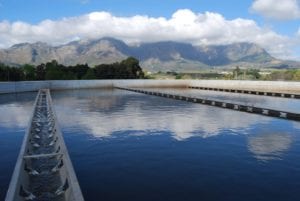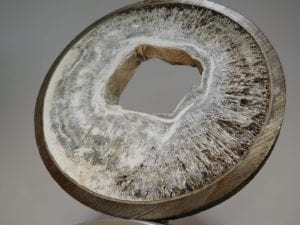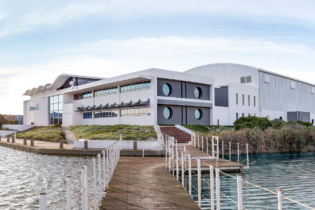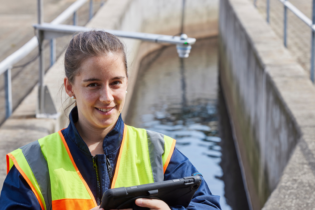
Graham Harlett, commercial director, WEC Projects
What will WEC be showcasing at IFAT Africa 2017?
GH We are excited to be showcasing a number of our high-value-add technologies including Nereda
®, our sludge treatment technologies and products that have been a mainstay at WEC for the last decade – such as our decentralised modular treatment systems.
Decentralised treatment plants are possibly more in the spotlight again today as a result of the severe drought we have been experiencing and also the continual rapid growth of communities that do not have access to reticulated and centralised treatment systems.
Could you expand on the benefits of Nereda technology?

Wemmershoek Nereda installation
Nereda is an extremely compelling proposition for bulk sewage treatment as it very effectively addresses many of the challenges our sector faces as a result of the sanitation infrastructure backlog.
First, we are all aware of the budget constraints that obstruct many bulk sewage treatment plant capacity upgrade projects. The constraints are on both the initial capital costs of the infrastructure, and also on the operational costs after commissioning.
Energy consumption is a major contributor to these operational costs and Eskom is facing a supply crisis. The issue is compounded by the fact that electricity prices are escalating at levels we have never experienced before in South Africa.
Second, we are running out of land. We can no longer afford to construct plants that don’t optimise land use. I don’t agree with people who say that, in some areas, space is not a constraint. This is a short-sighted position. If you can optimise space, then optimise space! Thirdly, we cannot compromise on the quality of the effluent we discharge to the environment.
Finally, we need to innovate. Innovation is what will provide us with a way out of this predicament. This means innovation in technologies, procurement, operations and in project financing. Everything! If your organisation is not innovating while the rest of the world is, you are – in relative terms – going backwards.
What excites me about Nereda is that it is such a well-rounded solution. For example, if you were building a bulk sewage treatment plant, Nereda would probably take up less than half the space compared to a conventional activated sludge plant. This is due to its innovative one-tank design, which allows all nutrient removal processes and final settling to happen in a single tank.
You do not need separate nutrient removal zones, nor do you require final settling tanks. What’s more, you get this incredible space saving, together with massive reductions in energy consumption. Add to that the possibilities of significant capex reductions. A Nereda reactor is typically much smaller than a conventional plant and so it is intuitive that your construction costs will be less.
Nereda also treats effluent to the highest quality that is not only comparable to conventional systems, but better with regard to nutrient removal. I feel that other technologies trade energy costs with a higher footprint, or effluent quality with energy costs. You don’t need to make that compromise with Nereda. It’s also a proven, reliable technology that can be implemented on a very large scale.
Are there good prospects in Africa?
We have deployed hundreds of decentralised treatment systems to provide drinking water to rural communities all over the continent, and have provided the process water treatment infrastructure for mines in all of the major mining areas. We are involved in both bulk sewage treatment projects and bulk water treatment projects in Africa.

WEC Projects’ annular packaged sewage treatment plant
Can you expand on WEC’s packaged treatment solutions?
We have been developing our packaged treatment offering for over a decade now and we really do consider ourselves experts when it comes to taking a treatment technology and packaging it into a modular/containerised plant. Our plants are tough, and their installation should be seriously considered.
Is the mini-hydropower solution for Mhlontlo Local Municipality part of a diversification strategy into the broader renewable energy market?
As far as projects that we have completed go, this one stands out as one of the best. Yes, it’s good to diversify but we felt it was a natural progression from creating energy and electricity from the wastewater stream. Why not create electricity from the clean water stream too? It makes sense to me not just because of the realities of our power supply issues, but because of how you can use an energy source like flowing water to rotate mechanical equipment that ultimately generates electricity.
What is WEC’s involvement in the biogas-to-energy market to date?
We are very involved in this sector in South Africa. We did something very special with the turnkey supply of the biogas-to-combined-heat-and-power plant (CHP) at Johannesburg Water’s Northern Wastewater Treatment Works. It’s an excellent example of an effective design/build procurement model.
I cannot see any reason why there shouldn’t be a biogas-to-energy plant on every single bulk sewage treatment works above a certain threshold. Here in South Africa, our installation is the only one of its kind currently in operation. Overseas, it is quite the opposite and you hardly find a plant that doesn’t have a CHP component attached to it.
We have successfully completed a number of biogas-to-energy projects in the private sector too. Our focus on biogas-to-energy solutions includes abattoirs, breweries, landfill applications and, of course, bulk sewage treatment installations.
Could you expand on the Struvex technology offering?

Struvite build-up in a pipe
Struvex technology enables us to recover phosphates from a wastewater plant in a controlled manner, which provides numerous benefits to the client.
By removing phosphates, you are able to increase how dry the sludge is and its dewaterability, considerably reducing sludge disposal costs. It also significantly reduces poly consumption at dewatering facilities.
Uncontrolled precipitation of phosphates causes struvite formation in pipeworks and can completely block pipes, causing expensive shutdowns and repair work.
By recovering phosphates, the cumulative build-up of phosphates in a plant is prevented. Furthermore, the removal of phosphates from the wastewater stream reduces total organic load on the works by eliminating the recycling of phosphates. Phosphates in the form of MAP also have a commercial value and can be sold to the fertiliser industry.
What are the current key challenges for South Africa’s water and wastewater markets?
I think our industry needs to have a discussion around procurement. I talk a lot about adding value; however, the systems and framework we work within must enable companies with value-adding capacity to transfer this to the client. We talk of innovation but, for some reason, reserve a discussion around innovation for technologies only. We need to innovate in all areas, including procurement.











